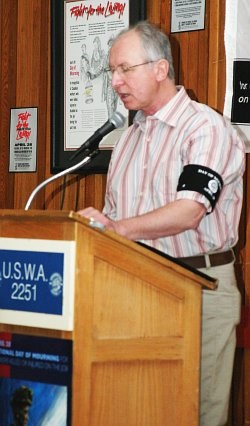Think a school is a safe place to work?
Think again, Terry Switzer, president of District 2 of the Ontario Secondary School Teachers' Federation, said yesterday.
Speaking at a National Day of Mourning event at the Steelworkers Hall for workers killed or injured on the job, Switzer talked about this month's mass slaying at Virginia Tech.
With 32 dead, that was the worst incident of its kind in modern U.S. history.
Switzer talked about old structures contaminated by toxic mold.
And he also referred to the fatal electrocution two years ago of a member of his union at Jean Vanier High School in Collingwood, Ontario.
As SooToday.com reported earlier this month, the Simcoe Muskoka Catholic District School Board was fined $100,000 for failing to take reasonable precautions to ensure the energy management systems technician was safe while working near live power.
Melanie Wheelan was also there yesterday, remembering the 2001 industrial accident in which a crackling 7,200-volt Great Lakes Power line fell across the body of her son Lewis, who lost two legs, his right arm and his right shoulder as a result.
Lewis tried going back to school, but was found dead in his Toronto-area apartment in August 2003, after the largest power blackout in North American history left his apartment without air conditioning.
Mike Da Prat, president of Steelworkers Local 2251, lambasted local writer Randy Russon for once referring to Algoma Steel workers as "sleeping on the job."
Cool-down periods are often needed by workers who experience thermal stresses that people who've not toiled in a steel mill could never appreciate, Da Prat said.
Da Prat talked about being personally exposed to polychlorinated biphenyls (PCBs) and asbestos during the initial years of his working life, with no one cautioning him that those materials might be dangerous.
The union boss expressed concern that some people who are supposed to be monitored under Algoma Steel's asbestos surveillance program are no longer being tracked.
Also participating in yesterday's Sault Ste. Marie observance was Irene Harris, secretary-treasurer, Ontario Federation of Labour. The following statement was issued by the OFL:
************************* TORONTO - "On April 28 we must bow our heads and remember all the workers killed and injured on the job. We must remember the anguish and the grief of families who received the phone call telling them a loved one was killed at work. We must remember the families and whole communities who had to watch loved ones suffer from occupational disease," said Irene Harris, secretary-treasurer, Ontario Federation of Labour.
"It takes knowledge, commitment and political action to get the changes that are so desperately needed," Harris said. "We do not accept that workers and their families have to trade their lives and health for a paycheque."
Pallbearers carried 315 Ontario workers to their graves last year as a direct result of workplace conditions.
Another 341,437 claimed compensation for work-related injuries.
Missing from the official record were an estimated 6,000 workers killed by cancer, lung disease and other ailments, all attributed to toxic exposures in their workplaces.
April 28 ceremonies allow all Canadians and people throughout the world to pay respect to those working people who have died or suffered injuries and diseases on the job.
While we mourn the dead, labour and all people must dedicate themselves to fight for the living and prevent this terrible and unnecessary toll.
The House of Commons, many provinces and municipalities observe the Day of Mourning with a minute's silence and many flags fly at half-mast on municipal buildings and provincial and territorial legislatures.
Irene Harris joined the Sault Ste. Marie & District Labour Council, injured workers and activists to honour workers killed and injured on the job.
*************************
